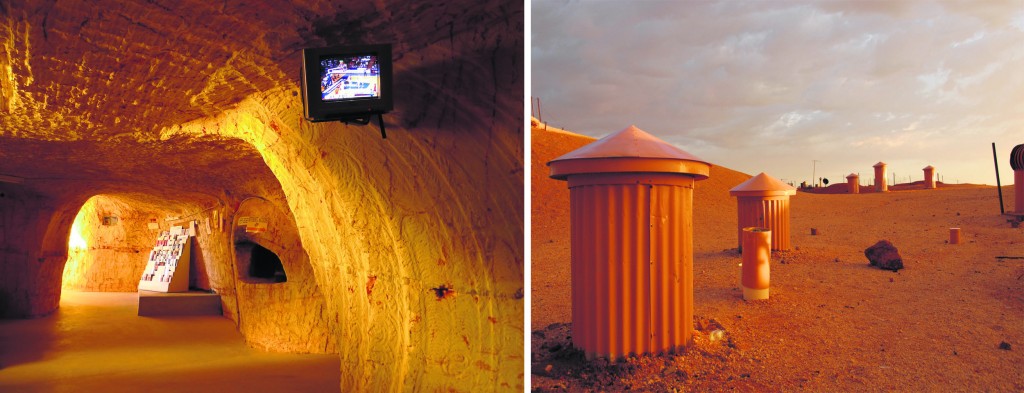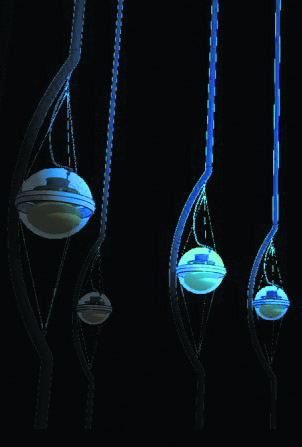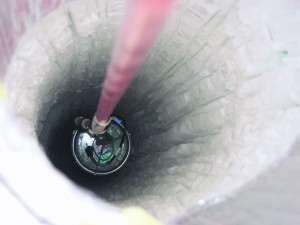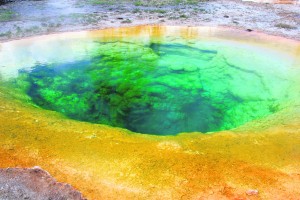MONDAY, 3 OCTOBER 2011
Deep below our feet lies a world mostly unexplored. It has been said that we know more about the dark side of the moon than we do about the depths of our oceans, and the same could apply deep in the Earth’s crust. Despite their isolation, underground and deep-water worlds are a hive of activity. Life has flourished in some of the most unimaginable places, adapting for survival in habitats we might have considered impossibly inhospitable. But subterranean life does not just consist of hardy bacteria: humans are also building homes underground, whether sheltering from extreme temperatures or simply being environmentally friendly. Engineers through the ages have also been tapping in: from Roman baths to modern-day electricity generation, they have been utilising the vast pool of geothermal energy that lies beneath. Even astrophysicists have begun to journey below the surface, building a telescope over a cubic kilometre in size within the Antarctic ice. There may be a huge amount that we have yet to learn about the nearest kilometres beneath our feet, but we have already made many fascinating and useful discoveries.To us, the 400°C hydrothermal fluids exiting deepwater fissures at pressures of up to 50,000 kilopascals (when we’ve evolved to enjoy a leisurely 101 kilopascals) may sound ‘extreme’, but over the last few decades scientists have suggested that might be a tad anthropocentric. They are now accepted as havens for a diverse web of crabs, fish and octopuses that are sustained by some unusual bacteria. These bacteria feed off the dissolved sulphur compounds, usually toxic to other organisms, abundant at the mouth of ‘black smokers’. The biodiversity supported by these chemosynthetic organisms, which use heat, methane and sulphur instead of sunlight as sources of energy, is only now being fully revealed. Some single-celled organisms have also been shown to use the dim light generated by black smokers as a source for photosynthesis. This has all been discovered in the 51 years since Jacques Piccard and Don Walsh first navigated 10.9 kilometres down into the Marianas Trench.
Since 1993, further deep sea exploration has also discovered over 300 new species of deep sea gastropod, as well as one quite fascinating species of mollusc. This particular snail has a foot mineralised with iron sulphide armour plating, making it frustratingly magnetic for anyone attempting a dissection with metallic tools. Elsewhere in the water column, the HADEEP collaborative project captured images of the deepest recorded fish in 2008—a suction-feeding snailfish 7.7 kilometres down in the Peru-Chile trench. Two years later they went further with a new species of shrimp, detected in the Izu-Bonin Trench at 9.3 kilometres.
As with many specialisms of science, the study of these remarkable organisms has developed its own terminology. Organisms with a preference for high pressures and temperatures are now termed ‘extremophiles’. This umbrella term also incorporates organisms tolerant of high or low pHs, immense altitudes, elevated radiation levels and extreme salinities. The greatest challenge to barophilic (‘pressure loving’) organisms is the effect pressure has on the physical properties, especially the fluidity, of cellular membranes. At high pressure the phospholipids, which make up the membranes that allow metabolic movement of structures into and out of cells, are crushed together. In response, barophiles universally express a far greater percentage of unsaturated fatty acids within this layer, resulting in an appropriately plastic membrane. The fantastic suite of specialisations being discovered in more and more deep sea organisms means some extremophiles truly are extreme ‘lovers’—‘obligatory barophiles’ are unable to withstand pressure less than 50,000 kilopascals.
Far from being simply zoological oddities, the study of extremophiles is big business—industries have been using ‘extremozymes’ for agricultural and laundry markets for decades. Taq polymerase, ubiquitous in labs around the world as the key enzyme for polymerase chain reactions (PCR), was derived from thermophilic bacteria found in Yellowstone National Park. Now it seems medicine and biotechnology may further benefit from the study of deep sea organisms, with extremophiles being studied in order to find novel chemotherapeutic agents. For instance, the vent bacteria Vibrio diabolicus might be key in studying and delaying blood clotting due to its sugar-residues. So as the fascinating depths of our oceans continue to amaze and provide potentially ground-breaking research, what has the ground right below us got to offer?
For over twenty years biologists have been aware that crammed in between the pores of the consolidated sediments of the Earth’s crust, an entire ecosystem of microorganisms exists. Earlier this year, for example, in borehole water filtered from the Beatrix gold mine in South Africa, a multicellular organism was found tolerating anaerobic conditions and temperatures of up to 41°C—over 1.3 kilometres under the surface of the crust. The discovery of Halicephalobus mephisto, a nemotode worm, not only expanded the range that multicellular life was known to inhabit, but also hinted at the resilience of life within those extreme habitats.
And we’re not going to stop being surprised anytime soon. Even at the South Pole, microbes have recently been found in the pores of ice crystals; resilient to prolonged darkness, an almost complete absence of water and exposure to ultraviolet radiation. This results in these single-celled prokaryotes sporting four copies of their genome, along with DNA repair mechanisms, to guard against the genetic damage caused by radiation. Furthermore, the discovery of Lake Vostok, lying four kilometres below the frozen surface and isolated for up to 25 million years, has brought to light a freshwater system as big as Lake Ontario in North America. The Arctic and Antarctic Research Institute based in St. Petersburg is currently completing a drilling exercise initially stopped in 1998 but resumed in 2004. After finally convincing the Antarctic Treaty Secretariat there are no fears of contaminating it with surface organisms, they will be the first team to investigate the water of the super oxygen-saturated lake for signs of life. Drilling stopped this February just hundreds of metres short of the lake, but is due to resume this December with the beginning of the polar summer. It is unknown whether extremophiles will be found within this frontier of Earth exploration, but whether or not life is found in the lake, the technological advances developed as part of this project will be of major interest to astrobiologists—similar ecosystems are hypothesized to be present on other celestial bodies, such as the satellites Ganymede and Europa.
A multitude of animal species may have adapted successfully to life below ground, but what about humans? Today, millions of people across the globe call an underground residence ‘home’, although the vast majority live far closer to the surface than their extremophile counterparts.
The most common motivation for moving underground is to avoid extreme temperatures on the surface. In Coober Pedy, the Australian outback town and self-declared opal mining capital of the world, almost half of the town’s 3,000 permanent residents live underground. Many of these homes, known as ‘dugouts’, are former mine shafts left behind by the opal industry. While the average daily temperature in Coober Pedy routinely exceeds 40°C and can drop to freezing overnight, the temperature underground is a constant and comfortable 20–25°C. Subterranean life in Coober Pedy is made possible by the local sandstone, which is easy to tunnel through, yet strong and stable. A coat of sealant on the dugout walls prevents dust, while vertical shafts extending into the rooms provide ventilation and natural light.
The same solution to the problem of staying cool is found in several desert villages around North Africa, most famously the Berber township of Matmata in Tunisia. Here residents live in caves excavated around the perimeter of large circular pits dug from the surrounding sandstone. Troglodyte (cave-dwelling) residences are thought to have been continuously present at Matmata from the 13th century onwards. The township was only ‘discovered’ in 1967, however, when heavy rains flooded the houses forcing residents to seek help from the Tunisian authorities. Today, Matmata survives largely as a result of its international fame—its subterranean hotel, the ‘Siri Diss’, acted as the set for Luke Skywalker’s home in the Star Wars films.
Underground extra-terrestrial accommodation may not be limited to films, however. Using ‘Themis’ (Thermal Energy Imaging System), NASA spacecraft have identified what appear to be caves on the surface of Mars, and are now investigating whether these might be suitable locations for a future base on the red planet. The caves would offer protection from the meteoroids, ultraviolet radiation and solar flares that continuously bombard the Martian surface. Caves are also the most plausible source of minerals, gases and possibly even ice that would be required by any future manned mission.
Back here on Earth, the world’s most populous troglodyte residences are, without a doubt, the yaodong caves of China. Stretching across six northern provinces, the ‘yaodongs’ (or ‘arched tunnels’) are thought to house around 40 million people. The caves are carved into hillsides composed of loess—a mixture of silt, sand and clay with a distinctive yellow colour. In summer, the caves are naturally cool, while in winter they are heated by a network of channels that distribute hot air from fireplaces to the rooms. Since the yaodongs are carved into hillsides that would be difficult to farm, they free up valuable arable land, making it possible to house large numbers of people with relatively little environmental impact.
At the South Pole, enforced self-sufficiency is a fact of life during the long polar winter. When the US military constructed the first South Pole Antarctic research station in 1956–57, they built part of the base underground to offer some protection against winter temperatures that could fall below -70°C. While the underground facility was successful in this respect, it had not been designed to cope with the ferocious polar winds. Each and every year, these led to snowdrifts more than one metre high accumulating on top of the building. Since this snow never thawed, the increasing weight on the roof eventually led to the base being abandoned in 1975 and a replacement constructed, this time above ground. The third, and current, South Pole station is not only above ground: it has been designed so that if snow accumulates unevenly over the top of the building, the structure can be ‘jacked up’ and re-levelled.
Looking out from such sites onto the barren landscape of Antarctica, one could be forgiven for thinking that you were as isolated as you could possibly be. Indeed, it is this isolation that draws astronomers to the Amundsen-Scott South Pole station, where they can study the stars without interference from artificial light, atmospheric pollution, and noise that invades all but the furthest reaches of the Earth. Isolation is exactly what the scientists at the IceCube neutrino telescope are looking for; buried one kilometre below the ice, it is not the traditional place to have a telescope, but then this is not a traditional telescope. This team of physicists are searching for neutrinos, but instead of looking up into the sky, they are looking down.
Neutrinos are among the smallest particles known to man, so small that their mass has yet to be determined. As their name suggests, they are electrically neutral, and this lack of electrostatic charge means that they barely interact with other forms of matter. In fact 99.99% of the time a neutrino will pass straight through the Earth. They are also incredibly abundant—trillions of them have passed through you in the time it took to read this sentence. But because it is so rare for a neutrino to interact with other matter, experiments to detect them need to be highly sensitive. However, this sensitivity can make them susceptible to interference from cosmic rays coming down through the atmosphere. To combat this interference, detectors are placed one kilometre underground, facing down towards the centre of the Earth. This way the Earth acts as a filter to deflect or absorb particles from the cosmic rays that can interfere with the neutrino telescope. Only particles that can pass straight through the Earth and come out the other side—like neutrinos—can be detected.
Its location at the South Pole allows the IceCube telescope to be larger than any other neutrino detector in the world. As neutrinos cannot be detected directly, the telescope searches for signs of another subatomic particle being produced, known as a muon. These muons are produced when the neutrino collides with something, such as a water molecule. By following the direction the muon came from, we can calculate the neutrino’s original trajectory. These muons are produced with a lot of energy and so travel at very, very high speeds—so fast that they can travel faster through water than light. Travelling faster than light produces a characteristic blue glow known as Cherenkov radiation, which is essentially the light equivalent of the sonic boom. It is the Cherenkov radiation that is detected by the telescope, which can be used to infer the presence, direction and energy of the neutrinos. Many neutrino telescopes use vast chambers (50,000 litres) of ultra-pure water, in which they wait for neutrinos to collide. However, at IceCube, they use the ice itself to form an experiment that is a cubic kilometre in size—approximately one trillion litres of ice.
Construction of IceCube took five years to complete, finishing in December 2010. Drilling could only happen during the austral summer each year, as it is the only time when planes can reach the South Pole. Using hot water drills, 86 strings were lowered down to 1.5-2.5 kilometres below the surface. At this depth, the immense pressure has driven out any imperfections or bubbles in the ice, leaving it almost completely pure and transparent. Each of the 86 strings has 60 ‘digital optical modules’, totalling 5160 detectors, each consisting of a photomultiplier to detect the blue light and a digitiser to maintain the fidelity of the signal on its 2.5 kilometres journey back to the surface. Such a large array of detectors produces an incredible amount of data (already over 400,000 gigabytes). For each muon detected below the ice, the data is cross-referenced with results from other sensors on the surface, to check for coinciding events. If a muon is observed at the surface before it reaches IceCube detectors, it could not have originated from a neutrino passing through the Earth and interacting with the ice, so is ignored.
Unlike photons or charged particles, neutrinos will not deviate from travelling in a straight line while hurtling from one galaxy to the next. This means we are able to trace the paths of neutrinos back to where they came from and produce a map of neutrino sources in the universe. This can be compared to what we have been able to observe from optical, infrared and X-ray telescopes. Combine that with measuring the energy of the incoming neutrinos and we can begin to pinpoint the locations of black holes, gamma ray bursts and supernova explosions. Understanding these events is all part of cracking the puzzle of dark energy, and buried under a billion tonnes of ice, thousands of detectors are looking for a faint blue flash of enlightenment.
In contrast to the freezing depths of the Antarctic, the ground beneath us also contains phenomenal amounts of heat. No one who has witnessed the eruption of a volcano, or the devastation of earthquakes, can doubt that there are huge amounts of energy stored inside the Earth. Some of this energy, known as geothermal energy, is released as heat. It comes from energy stored as the Earth formed, as well as from naturally occurring radioactive elements that release energy as they decay.
Of course, not all manifestations of this energy are destructive. The Yellowstone region of the USA is famous for its spectacular geysers, having one of the highest concentrations in the world. There are also hot springs and pools with beautiful coloured rocks, where minerals from deep within the Earth are carried to the surface by deep flowing water. The driving force for geysers and hot springs comes from the pool of molten rock (magma), which sits relatively close to the surface in Yellowstone National Park.
Another place with similar geothermal features is the East African Rift System. Sitting on top of some of the thinnest continental crust on Earth, there are places where steam vents and hot springs have been used by local people for thousands of years. Similarly, the Japanese Onsen (literally ‘hot springs’ in Japanese) has always been a popular bathing site, and the Romans used hot springs for indoor heating as well as for public baths.
In the last 60 years, the development of new technologies means that we are able to exploit geothermal energy more effectively than our ancestors. This has been achieved in two ways: electricity generation and the direct utilisation of heat. While electricity is a more versatile form of energy, generating it from geothermal energy is more difficult, requiring a more favourable site. Approximately 70 countries have the infrastructure in place to use the direct heat from geothermal sources, as opposed to 24 countries that are able to generate electricity.
For electricity generation, there are several types of power plants, all of which are very similar to those that run on more conventional fossil fuels—they base their operation on steam driven turbines. The difference is that the steam is obtained either directly from a geothermal source, such as a very hot underground water reservoir, or by using the heat from deep underground to turn water into steam. This requires drilling a few kilometres into the ground to gain access to the hot underground water, or injecting water into hot rocks, which then comes back to the surface as steam.
The hot water that emerges from the ground can also be used directly. In some countries with rich geothermal resources, such as Iceland, the hot water coming from springs or from artificial wells is used to heat buildings. The first few metres of the ground beneath our feet tend to remain at a fairly constant temperature of 10–16˚C. In winter, the ground is warmer and heat goes through a geothermal heat exchanger (a series of pipes buried underground) into the house. In summer, the heat goes the other way, from the hotter building into the cooler ground. As electricity is only required to power the pumps that drive the fluid through the exchanger pipes, it is much more environmentally friendly than running an air conditioning system or central heating.
As fossil fuel stores start to run low, and with increasing concerns about the damage to our environment, using the energy under our feet is an attractive option. Not only is it available at all times, unlike solar or wind energy, geothermal power plants can also be adapted to make the most efficient use of the geothermal resources available.
We seldom think of what lies beneath our feet as we go about our daily lives. Earth’s internal energy gives us a mechanism for generating electricity; it powers life at ocean depths sunlight can never reach; it provides a sheltered environment for relatively cheap, effective and efficient housing and laboratories; but the most exciting part of all is that we have only hit the tip of the iceberg—as technology advances, we can be prepared to see many more exciting discoveries coming from the world below.
Nick Crumpton is a PhD student in the Department of Zoology
Ian Le Guillou is a PhD student in the Department of Biochemistry
Louisa Lyon is a postdoctoral researcher in the Department of Experimental Psychology
Wendy Mak is a PhD student in the Department of Physics








